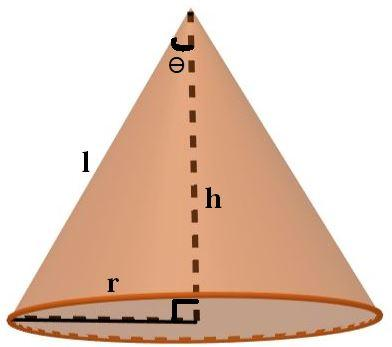
Show that the semi-vertical angle of the cone of the maximum volume and of given slant height is
Answer
490.5k+ views
Hint: To solve this problem we should have basic knowledge about trigonometry and geometry. To solve this first of all we will assume the height, slant height and radius of the cone as h, l and r respectively. Then we will express h and r in terms of l using angle
Complete step by step answer:
We have to prove that the semi-vertical angle of the cone of the maximum volume and of given slant height is
So first of all for better understanding we will draw the diagram as follows,

We have assumed height, slant height and radius as h, l and r respectively.
We know that in the figure,
And,
And we know that volume of a cone is given as,
Using equation 1 and 2 we get,
Now to find the maxima we will have to differentiate the above expression as,
Taking
We know that
Dividing and multiplying by
Now at maxima
We know that
As all
But for the term
Hence
Hence proved.
Note: To solve these kinds of questions you need to have basic knowledge about trigonometry, geometry and also you should know how to find the maxima, minima using the first derivative test. If you don’t know then kindly go through these topics and try again to solve this problem. As this problem involves a lot of calculation so you need to be careful about this while solving.
Complete step by step answer:
We have to prove that the semi-vertical angle of the cone of the maximum volume and of given slant height is
So first of all for better understanding we will draw the diagram as follows,

We have assumed height, slant height and radius as h, l and r respectively.
We know that in the figure,
And,
And we know that volume of a cone is given as,
Using equation 1 and 2 we get,
Now to find the maxima we will have to differentiate the above expression as,
Taking
We know that
Dividing and multiplying by
Now at maxima
We know that
As all
But for the term
Hence
Hence proved.
Note: To solve these kinds of questions you need to have basic knowledge about trigonometry, geometry and also you should know how to find the maxima, minima using the first derivative test. If you don’t know then kindly go through these topics and try again to solve this problem. As this problem involves a lot of calculation so you need to be careful about this while solving.
Recently Updated Pages
Master Class 9 General Knowledge: Engaging Questions & Answers for Success

Master Class 9 English: Engaging Questions & Answers for Success

Master Class 9 Science: Engaging Questions & Answers for Success

Master Class 9 Social Science: Engaging Questions & Answers for Success

Master Class 9 Maths: Engaging Questions & Answers for Success

Class 9 Question and Answer - Your Ultimate Solutions Guide

Trending doubts
Give 10 examples of unisexual and bisexual flowers

Draw a labelled sketch of the human eye class 12 physics CBSE

Differentiate between homogeneous and heterogeneous class 12 chemistry CBSE

Differentiate between insitu conservation and exsitu class 12 biology CBSE

What are the major means of transport Explain each class 12 social science CBSE

a Tabulate the differences in the characteristics of class 12 chemistry CBSE




